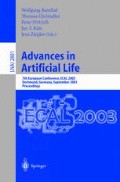Abstract
The propagation of text expressed in an n-letter alphabet, An, may be effected by any of the set of associated permutations Sn, applied repeatedly or in suitable combinations until the original text is reproduced. Scaling as n!, the number of possible permutations rapidly becomes intractable, and individual permutations cannot be considered for all but the smallest alphabets. This paper explores how a molecular medium, in which replication must proceed by means of template propagation, might serve to limit the number of permutations which may be reasonably find a molecular expression. The analysis suggests that the number of molecularly realisable permutations is restricted to a limited variety of permutation types, scaling linearly with alphabet size. It is also suggested that alphabets with odd numbers of letters may be less accessible than alphabets with even numbers of letters.
Access this chapter
Tax calculation will be finalised at checkout
Purchases are for personal use only
Preview
Unable to display preview. Download preview PDF.
References
Stauffer, A., Sipper, M.: An Interactive Self-Replicator Implemented in Hardware. Artificial Life 8, 175–183 (2002)
Hull, D.: Replication, The Stanford Encyclopedia of Philosophy (Winter 2001 Edition), Zalta E.N. (ed.), plato.stanford.edu/archives/win2001/entries/replication/
Lawrence, D.S., Jiang, T., Levett, M.: Self-Assembling Supramolecular Complexes. Chem. Reviews 95, 2229–2260 (1995)
Stahl, W.R., Goheen, H.E.: Molecular Algorithms. J. Theor. Biol. 5, 266–287 (1963)
Hu, W., Fukugita, M., Zaldarriaga, M., Tegmark, M.: Astrophysical Journal, vol. 549, pp. 669–680 (2001)
Biggs, N.L.: Discrete Mathematics, Oxford, p. 423 (1989)
Ibid at p. 100
Wang, M.D., Schnitzer, M.J., Yin, H., Landick, R., Gelles, J., Block, S.M.: Force and Velocity Measured for Single Molecules of RNA Polymerase. Science 282, 902–907 (1998)
Cox, M.M., Goodman, M.F., Kreuzer, K.N., Sherratt, D.J., Sandler, S.J., Marians, K.J.: The Importance of Repairing Stalled Replication Forks. Nature 404, 37–41 (2000)
Szathmáry, E.: What is the Optimum Size for the Genetic Alphabet? Proc. Nat. Acad. Sci. 89, 2614–2618 (1992)
Peters, M., Rozas, I., Alkorta, I., Elguero, J.: DNA Triplexes: A Study of Their Hydrogen Bonds. J. Phys. Chem. B 107, 323–330 (2003)
Sijbesma, R.P., Beijer, F.H., Brunsveld, L., Folmer, B.J.B., Hirschberg, J.H.K.K., Lange, R.F.M., Lowe, J.K.L., Meijer, E.W.: Reversible Polymers Formed from Self- Complementary Monomers using Quadruple Hydrogen Bonding. Science 278, 1601–1604 (1997)
Zimmerman, S.: Supramolecular Polymer Chemistry and the Origin of Life. In: XIIth Internations Conference of Supramolecular Chemisrtry, October 6–11, Israel (2002)
Mac Dónaill, D.A.: A Parity Code Interpretation of Nucleotide Alphabet Composition. Chem. Comm., 2062–2063 (2002)
Author information
Authors and Affiliations
Editor information
Editors and Affiliations
Rights and permissions
Copyright information
© 2003 Springer-Verlag Berlin Heidelberg
About this paper
Cite this paper
Mac Dónaill, D.A. (2003). Molecularly Accessible Permutations. In: Banzhaf, W., Ziegler, J., Christaller, T., Dittrich, P., Kim, J.T. (eds) Advances in Artificial Life. ECAL 2003. Lecture Notes in Computer Science(), vol 2801. Springer, Berlin, Heidelberg. https://doi.org/10.1007/978-3-540-39432-7_5
Download citation
DOI: https://doi.org/10.1007/978-3-540-39432-7_5
Publisher Name: Springer, Berlin, Heidelberg
Print ISBN: 978-3-540-20057-4
Online ISBN: 978-3-540-39432-7
eBook Packages: Springer Book Archive

